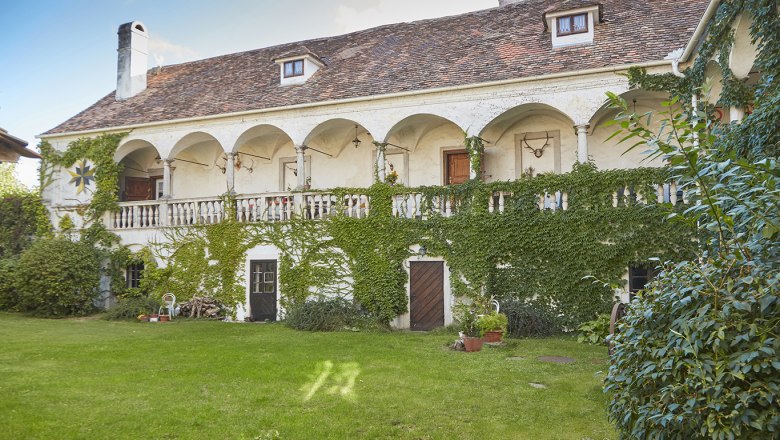Zogelsdorf Castle
A Baroque castle on a local village road – unmistakable, a genuine inside tip.
Just 3 km south of Eggenburg in the Horn District, a former noble residence is currently inhabited and being lovingly cared for. Zogelsdorf Castle (German: Schloss Zogelsdorf) near the famous local limestone quarry is younger than you might think yet old enough to tell a centuries-old story. The Orders Museum brings the era of the crusaders to life while the nature trail offers pearls of Celtic wisdom. Take time and enjoy!
A rediscovered gem
Zogelsdorf was already mentioned in 1122 as Chadolt de Zoclindorf. The two brothers Chunradus and Tagno de Zogelsdorf are named as the owners. It may have once been a fortification in the style of the High Middle Ages but that version no longer exists today. Parts of today’s castle are more than 600 years old. From 1522 on, a number of different noble families owned the estate. The structure was transformed in 1670 into a small Baroque castle following major renovation and enlargement. In 1831 an inn was set up in the castle but just eight years later, the Suttner family assumed ownership and Zogelsdorf Castle became a noble residence once again. It was home to the imperial court in 1848 and in the years thereafter, to the members of the Imperial War Ministry. The current owners are the Perko-Greiffenbühl family. They live there and see to the maintenance of the property.
Between different worlds
The core of the two-story structure dates back to the 16th and 17th centuries but changes undertaken in the 19th and 20th centuries are readily visible. For instance, the entrance hall and the other rooms on the ground floor have 16th c barrel vaulting whereas the wrought iron grids and doors date back to the first half of the 19th c. The south front is characterized by a central baluster balcony with scroll consoles and a pent roof resting on two Tuscan columns. In the southwest wing, doors have profiled stone jambs. The facades are rendered in white and the red-white-red shutters on several upper floor windows set a striking accent. An enclosure comprising quadrangular pillars with pyramidal tops in front of the south facade is all that has been preserved of the former gardens. Today’s wildlife garden was laid out in 1967 and is still home to far older structures, which have been integrated into the overall scheme. You uncover one detail after another here.
Carved in stone
From the Bronze Age well into the 20th c: The deposits of Zogelsdorfer (calcareous) sandstone not far from the castle have been quarried for more than 3,000 years. It is one of Austria’s major natural stones for use as ashlars. The material excavated from here has gone into the construction of many sights including St. Stephen’s Cathedral, St. Charles Church or Schönbrunn Palace in Vienna and Altenburg Abbey. What properties does this stone have, to what uses is it put, what makes it so special? To find out, visit the stonemason house in Zogelsdorf, an artistic paradise of age-old sculpture!
Of knights and rituals
If you are fascinated by the days of the crusaders, the Orders Museum is just the right place to go: decorations, honors, medals, order insignia and the true stories behind them! The nature trail in the garden takes you through the premises and past 80 native trees and bushes – all with interesting tales to tell. In the Celtic tree circle, you find the predecessors of the Zodiac – and discover new things about yourself!





